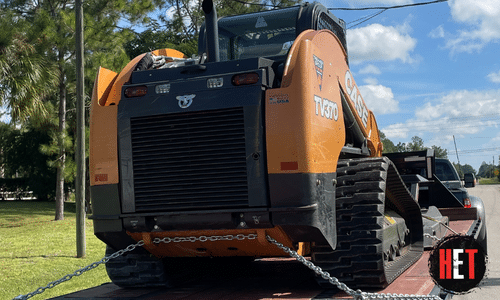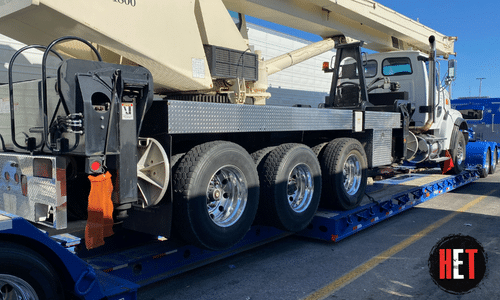Small Equipment Versus Large Equipment Transport

William Thomas / January 2021
It is not a simple task to transport small equipment or large equipment in a manner that is both safe and legal. When working with some of the most delicate small or large pieces of equipment ever made, it is best to follow a set routine for loading, transporting, and unloading the equipment.
Equipment that is considered small can easily be loaded within the transportation vehicle and usually doesn’t need any transportation permits or escorts. Generally, these are known as oversize load transports. Unlike small equipment transportation, large equipment transportation is more involved. The term “large equipment” refers to any piece of equipment that must comply with certain size and weight-related transit permits in order to be considered legal. In the majority of states, it is possible to move equipment weighing up to 40,000 pounds without having to submit an application for size and extra weight permits.

Small Equipment Transport
Transportation of equipment may vary greatly depending on the equipment size. As earlier mentioned, small equipment can easily be loaded onto the trucks using manpower or a forklift. The equipment can then be fastened enough to minimize any movement that may cause damage or instability of the delivery truck. Then, it is transported to the place where it will be delivered without any extra licenses, guards, or restricted routes.

Transport Your Equipment Today
Heavy Equipment Transport is always available for a quote. Fill out the form or give us a call now! (888) 730-2951
Large Equipment Transportation
Large equipment transportation is a major aspect of the transportation sector, and additional licenses, pilot and escorts, or even restricted routes are required, which may differ from state to state. Each transportation project requires a thorough and specialized procedure to guarantee safe transportation.
The type of transportation chosen for a given trip may vary, and the choice is often made depending on the weight and size of the equipment being transported.
a. Lift On / Lift Off
Lift on and lift off, often known as Lo/Lo, is a technique for moving heavy equipment that involves using a crane to move the equipment onto and then off the transport trailers and conveyances. In comparison to other techniques, this one is rather straightforward for moving large equipment.
In order to get a proper crane to lift equipment and a team of competent professionals enough to perform this service, companies may have to spend substantially more than if the equipment could roll or be transported similarly.
b. Roll-On / Roll-Off
Roll-on/roll-off is the simplest and fastest way to transport machinery and equipment if it can be rolled. Large wheeled equipment may be loaded into trucks, ships, or containers. This saves time and money in the loading process because of the reduced manpower.
c. Container Transportation
Container transportation makes loading and unloading machinery and equipment easier. This method is the most common, but if the equipment is larger than 20 or 40 feet, one may run into difficulties. Due to the restricted capacity of containers, one may need to disassemble the equipment to fit. This approach requires a lot of effort and time, so it’s not always the best for delivering large equipment.
Factors Influencing the Transportation Costs of both Small and Large Equipment
Even though it’s not possible to give an exact transportation cost, there are ways to get a good idea of how much transportation may cost. The cost depends on a number of factors, irrespective of equipment size.
Distance of Transport
The distance from one place to another affects prices. The farther the final destination is, the more gasoline is needed to bring the shipment there. Meaning, far-off places will cost more.
Another aspect to consider is global events that affect the supply chain, such as increasing gasoline costs. Transportation charges will be raised to compensate for fuel expenses.
The Size of the Shipment
The cost of transporting equipment increases with its size and weight. A small bulldozer or skid loader may be moved for less than a large earthmover.
Permit Cost For Transport
Heavy equipment may require specialized trucks, experienced drivers, pilot cars, and escort vehicles. Because of these factors, large equipment will cost much more than small equipment.
Enclosed vs. open transport
The cheapest and most popular way for moving large and small equipment is open-air transport on a truck bed. Some companies, nevertheless, are ready to cover the equipment with covers. Or, if the equipment is small enough or can be taken apart for transport, they might be able to put it in a standard shipping container.
Assembly and disassembly
For large equipment that has to be transported in many shipments, the company may provide disassembling and reassembling services. Although very practical, this does raise the total transportation cost.
Delivery time frame
A delivery with a more flexible time frame will always have lower overall costs than a delivery with a faster delivery time.
Final Transport Thoughts
It is advisable to assess the transportation company’s risk management policy based on how durable or delicate the equipment is. This may influence whether the equipment arrives safely or not. If you’re transporting a valuable item, have a professional supervisor loading and unloading and have the asset’s value evaluated before and after transportation. This value is required for commercial insurance.

William Thomas
Heavy Transport Specialist
Being able to lead a team of such talented logistics agents has been a wonderful experience over the past ten years. If you would like to know anything more about the heavy equipment transport services we offer, don't hesitate to give us a call!